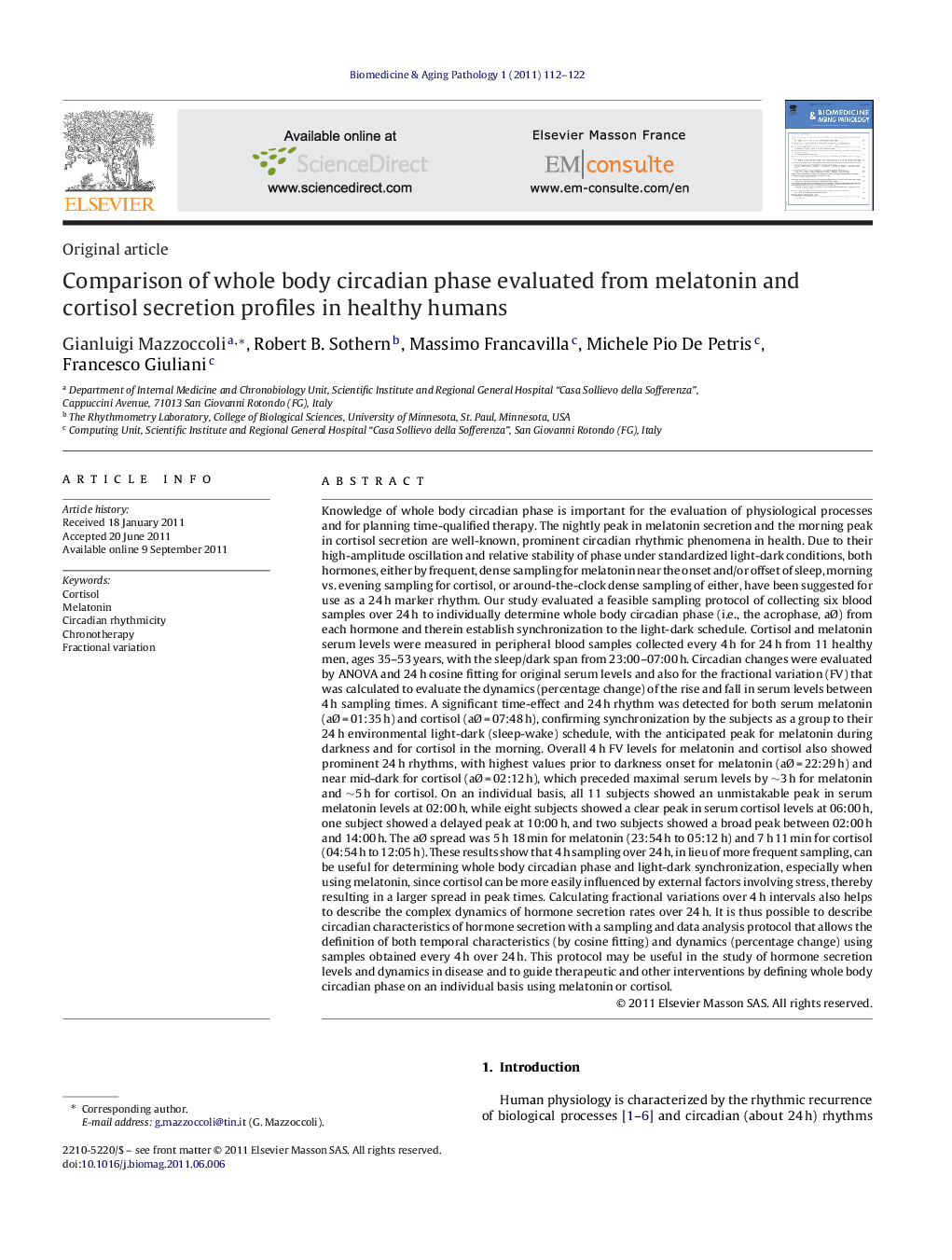| Article ID | Journal | Published Year | Pages | File Type |
|---|---|---|---|---|
| 2576359 | Biomedicine & Aging Pathology | 2011 | 11 Pages |
Knowledge of whole body circadian phase is important for the evaluation of physiological processes and for planning time-qualified therapy. The nightly peak in melatonin secretion and the morning peak in cortisol secretion are well-known, prominent circadian rhythmic phenomena in health. Due to their high-amplitude oscillation and relative stability of phase under standardized light-dark conditions, both hormones, either by frequent, dense sampling for melatonin near the onset and/or offset of sleep, morning vs. evening sampling for cortisol, or around-the-clock dense sampling of either, have been suggested for use as a 24 h marker rhythm. Our study evaluated a feasible sampling protocol of collecting six blood samples over 24 h to individually determine whole body circadian phase (i.e., the acrophase, aØ) from each hormone and therein establish synchronization to the light-dark schedule. Cortisol and melatonin serum levels were measured in peripheral blood samples collected every 4 h for 24 h from 11 healthy men, ages 35–53 years, with the sleep/dark span from 23:00–07:00 h. Circadian changes were evaluated by ANOVA and 24 h cosine fitting for original serum levels and also for the fractional variation (FV) that was calculated to evaluate the dynamics (percentage change) of the rise and fall in serum levels between 4 h sampling times. A significant time-effect and 24 h rhythm was detected for both serum melatonin (aØ = 01:35 h) and cortisol (aØ = 07:48 h), confirming synchronization by the subjects as a group to their 24 h environmental light-dark (sleep-wake) schedule, with the anticipated peak for melatonin during darkness and for cortisol in the morning. Overall 4 h FV levels for melatonin and cortisol also showed prominent 24 h rhythms, with highest values prior to darkness onset for melatonin (aØ = 22:29 h) and near mid-dark for cortisol (aØ = 02:12 h), which preceded maximal serum levels by ∼3 h for melatonin and ∼5 h for cortisol. On an individual basis, all 11 subjects showed an unmistakable peak in serum melatonin levels at 02:00 h, while eight subjects showed a clear peak in serum cortisol levels at 06:00 h, one subject showed a delayed peak at 10:00 h, and two subjects showed a broad peak between 02:00 h and 14:00 h. The aØ spread was 5 h 18 min for melatonin (23:54 h to 05:12 h) and 7 h 11 min for cortisol (04:54 h to 12:05 h). These results show that 4 h sampling over 24 h, in lieu of more frequent sampling, can be useful for determining whole body circadian phase and light-dark synchronization, especially when using melatonin, since cortisol can be more easily influenced by external factors involving stress, thereby resulting in a larger spread in peak times. Calculating fractional variations over 4 h intervals also helps to describe the complex dynamics of hormone secretion rates over 24 h. It is thus possible to describe circadian characteristics of hormone secretion with a sampling and data analysis protocol that allows the definition of both temporal characteristics (by cosine fitting) and dynamics (percentage change) using samples obtained every 4 h over 24 h. This protocol may be useful in the study of hormone secretion levels and dynamics in disease and to guide therapeutic and other interventions by defining whole body circadian phase on an individual basis using melatonin or cortisol.
